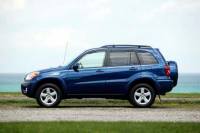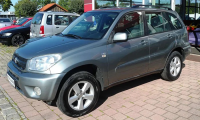The 2005 model year RAV 4 belonged to the upgraded CA20 generation, which at the end of the year gave way to the new crossovers of the XA30 generation. The Japanese concern offered cars with short and extended base, differing in interior dimensions and number of doors. Officially supplied to Europe, the cars were equipped with 150-horsepower petrol engine, and for some markets a supercharged diesel engine was available.
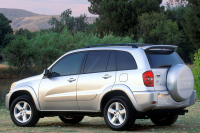
The European market was supplied with all-wheel drive and a centre differential. Front-wheel drive versions were imported from Japan and the United States. The long wheelbase trucks had a comfortable interior for up to 5 adults.
The spare wheel was mounted on the flap of the rear lid of the boot, which allowed a larger load capacity. Bodywork is finished in high-gloss or metallic paints.
MAIN FEATURES
New architectural design on Presnya
The cars were equipped with a welded body of load-bearing type with additional sub-frames for installation of suspension elements. Due to the smooth lines and reduced number of protruding parts, the drag coefficient was reduced. The machines used independent suspension with double-acting shock absorbers and anti-roll bars. But because of high profile tyres comfortable speed on the highway was not more than 120-130 km/h.
TECHNICAL .

The engine was mounted transversely in the engine compartment, the European standard engine was 1998 cc and developed 150 bhp at 6000 rpm. A VVT-i system was to be installed, and the high compression ratio required gasoline of grade A-95 or better. In addition to the 5-speed synchromesh transmission, a four speed manual transmission was available. It had permanent four-wheel drive, and the disc brakes were hydraulically actuated with a vacuum booster connected to a pedal.
OPERATING
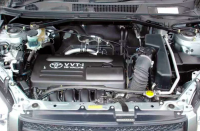
The ACA20 and ACA21 (3 and 5 door respectively) were supplied to the European market, with ground clearance of 195mm. When driving on the ground, the unfortunate position of the rear shock absorbers, which hit bumps and tree roots, was a major drawback. Top speed was 185 km/h (ACA21 version) and acceleration to 100 km/h takes 10.6 seconds. Average fuel consumption was from 8.8 to 9.3 liters, and in city mode increased to 12.4 liters per "hundred".
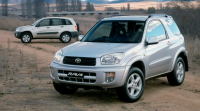
The fuel tank held 57 liters, and the luggage compartment had a capacity of 400 liters (1150 liters when the couch was folded down).
APPEARANCE AND DESIGN
Cars for Japanese market were different in positioning of a steering wheel, different headlights and installing rear-view mirror on the front left fender (in addition to the element on the regular place on the door). Budget modifications for Australian market were equipped with plastic trim and unpainted bumper. Aside from the aluminum alloy rims, pressed wheels were available. 16" was the standard, but some markets received 17" wheels.
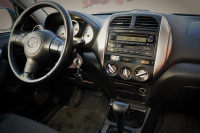
INTERIOR
Second generation of the Rav4 saloon
Smooth lines dominated the interior design, using soft plastic with a deep texture pattern. Instruments were located in wells, improving visual perception of readings in bright sunlight. In the centre of the dash was the climate control air vents, window for a 2 Din stereo, auxiliary buttons, and heater and air conditioner controls. All buttons and levers were located at arm's length, reducing the burden on the driver and increasing comfort.
Interior of the second-generation Rav 4
The seats and door cards were finished in hard-wearing fabric or leather. The front seats had faint side support rollers, and in addition to adjustment, height adjustment was used. The rear sofa could be folded down 50:50 to provide extra luggage space. Many trim levels varied according to equipment and market (e.g. in Japan, Wide Sport, X and X "G Package" versions were available, and models with a swivel-retractable front passenger seat were available).
BODY .
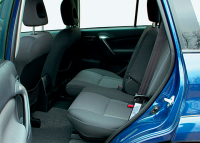
The bonnet was flat and sloping, with the grille in a metal grille panel. Headlamps with plastic diffusers partially covered the sides of the fenders. Around the wheel arches were plastic extensions, painted in the same colour as the body. Protective covers were also fitted on the side of the doors, with a matte black surround around the glazing.
Roof rails were fitted as standard equipment, and the spare wheel had a plastic cover painted in the same colour as the crossover.
SECURITY SYSTEM
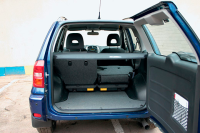
Front airbags were fitted as standard, while some versions had airbags in the seat backs and roof pillars. ABS with Electronic Force Distribution and Emergency Brake Assist were fitted as standard. Vehicle directional stability control, augmented with anti-skid protection, was also standard equipment. Inertia safety belts and height-adjustable injury-insensitive head restraints were available for driver and passengers.
The cars in the European market were offered in several versions, differing by a list of installed equipment. The standard equipment included manually controlled air conditioner with an air filter, electrically operated side windows and mirrors. Heated rear window with optional washer and cleaner was also available. All 2005 RAV4s used instrument cluster with tachometer, speedometer, dial indicators for engine temperature and fuel level.
A central locking system was provided, and occupants could disable the safety by turning a plastic dial located near the release handle. Cupholder slots were provided in the console between the front seats. Cigarette lighter and ashtray were fitted as standard.
Regardless of equipment, the floor was covered with dark carpeting with additional noise insulation, and the glove box was illuminated.
STANDART 2.0 AT 4WD
The base model Standart (or R1 in 2005) could be equipped with automatic transmission with the lever in the floor. Steering wheel adjustable for installation angle, and a stereo with CD player and radio was installed. Front airbags and ABS with Emergency Brake Assist were fitted as standard equipment. An electronic clock above the climate control unit was also standard.
Standart 2.0 AT 4WD.
Improved versions with the R2, R3 and R4 ratings are available. The vehicles could be equipped with additional airbags, directional stability system and multimedia centre with additional features. The steering wheel and shift knob cover were leather-finished, and some models had a steering wheel with multimedia control buttons.
Optional equipment included parking sensors located in the rear bumper. A standard front armrest with hinged lid and storage compartment for small items was fitted. Heated cushions and front seat backs are fitted, and manual lumbar support adjustment is available. The RAV4 for the Japanese market offered an air ionizer and optional body kit, which gave the crossover a sporty appearance.
Read also: Charger for car battery
ADVANTAGES AND DISADVANTAGES
RAV4 advantages noted by owners:
Comfortable cabin and suspension;
reliability of the chassis and powertrain;
easy selection of spare parts;
good acceleration dynamics;
transformation of saloon is provided.
Disadvantages of the 2005 model year crossover:
high fuel consumption;
poor standard sound insulation;
high mileage offered on the secondary market cars;
small interior (concerns the 3-door version);
large turning radius.
